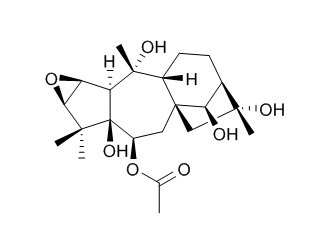Rhodojaponin II
Rhodojaponin II correlates pretty well with cardiotoxicity.
Inquire / Order:
manager@chemfaces.com
Technical Inquiries:
service@chemfaces.com
Tel:
+86-27-84237783
Fax:
+86-27-84254680
Address:
1 Building, No. 83, CheCheng Rd., Wuhan Economic and Technological Development Zone, Wuhan, Hubei 430056, PRC
Providing storage is as stated on the product vial and the vial is kept tightly sealed, the product can be stored for up to
24 months(2-8C).
Wherever possible, you should prepare and use solutions on the same day. However, if you need to make up stock solutions in advance, we recommend that you store the solution as aliquots in tightly sealed vials at -20C. Generally, these will be useable for up to two weeks. Before use, and prior to opening the vial we recommend that you allow your product to equilibrate to room temperature for at least 1 hour.
Need more advice on solubility, usage and handling? Please email to: service@chemfaces.com
The packaging of the product may have turned upside down during transportation, resulting in the natural compounds adhering to the neck or cap of the vial. take the vial out of its packaging and gently shake to let the compounds fall to the bottom of the vial. for liquid products, centrifuge at 200-500 RPM to gather the liquid at the bottom of the vial. try to avoid loss or contamination during handling.
PLoS One.2022, 17(6):e0268505.
Int J Mol Sci.202, 25(17):9246.
Food Funct.2022, 13(13):6923-6933.
J Anal Toxicol.2021, bkab015.
Microchemical Journal2024, 200:110475
J of Pharmaceutical Analysis2020, doi: 10.1016
Food Res Int.2020, 133:109130.
J Control Release.2021, 336:159-168.
Int J Mol Sci.2022, 23(24):16000.
Molecules.2023, 28(9):3685.
Related and Featured Products
J Ethnopharmacol. 2014 Nov 18;157:69-78.
The integrated pharmacokinetics of major rhodojaponins correlates with the cardiotoxicity after oral administration of Rhododendri Mollis Flos extract in rats.[Pubmed:
25256689]
Rhododendri Mollis Flos (RMF), termed as Naoyanghua in Chinese, is a traditional anti-rheumatoid arthritis and bruises herb with associated cardiotoxicity. The predominant rhodojaponins occurring in RMF are responsible for its efficacy and toxicity. The narrow therapeutic window of rhodojaponins necessitates monitoring the pharmacokinetics and pharmacodynamics so as to ensure the safety in practical applications of RMF.
METHODS AND RESULTS:
Fifty-four male Sprague-Dawley rats were divided into a control group, a low-dose group and a high-dose group. After oral administration of RMF extract, the cardiotoxicity of RMF was evaluated by assessing ventricular function and by measuring the plasma levels of LDH, CK-MB and AST. Then, an LC-MS method was established to determine the rat plasma concentrations of three major rhodojaponins including rhodojaponin I, Rhodojaponin II and Rhodojaponin III (R-I, II and III) and was applied to pharmacokinetic study. Finally, based on an AUC-weighting approach, the integrated pharmacokinetics of three rhodojaponins was determined. Compared with control group, cardiotoxicity was observed in RMF-treated rats with left ventricular dysfunction and with the continuously increased levels of LDH and CK-MB in a dose-dependent manner. The pharmacokinetic parameters (AUC0-t, AUC0-∞, t1/2, Tmax and Cmax) for R-I, II and III were markedly different, and the integrated pharmacokinetics was therefore converted to describe the holistic pharmacokinetic profiles of R-I, II and III, which correlated pretty well with cardiotoxicity.
CONCLUSIONS:
It was found that myocardial damage was elicited by RMF extract in a dose-dependent manner and the plasma levels of LDH and CK-MB could reveal the severity of myocardial injury as potential markers. This study also highlighted the potential of integrated pharmacokinetics to provid a more comprehensive understanding of the relationship between the pharmacokinetic behaviors of traditional Chinese herbal medicine and its efficacy.
J Nat Prod. 2004 Nov;67(11):1903-6.
Diterpenoids from the flowers of Rhododendron molle.[Pubmed:
15568787 ]
METHODS AND RESULTS:
Five new grayanane-type diterpenoids, rhodomolleins IX (1), rhodomollein X (2), rhodomollein XI (3), rhodomollein XII (4), and rhodomollein XIII (5), a new kalmane-type diterpenoid, rhodomollein XIV (6), and seven known diterpenoids, grayanotoxin II, rhodomollein I and rhodomollein XIX, Rhodojaponin II, Rhodojaponin III, and rhodojaponin VI (7), and kalmanol, were isolated from the flowers of Rhododendron molle.
CONCLUSIONS:
The structures of 1-6 were elucidated by spectroscopic methods, including 1D and 2D NMR experiments.



